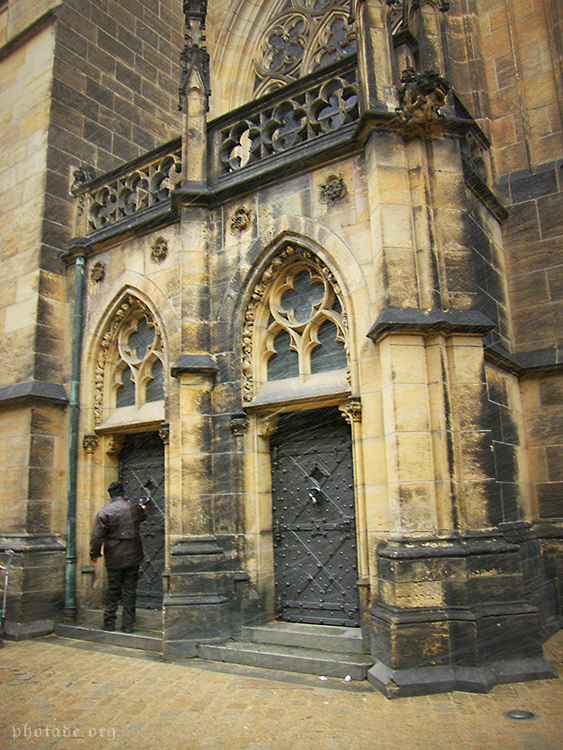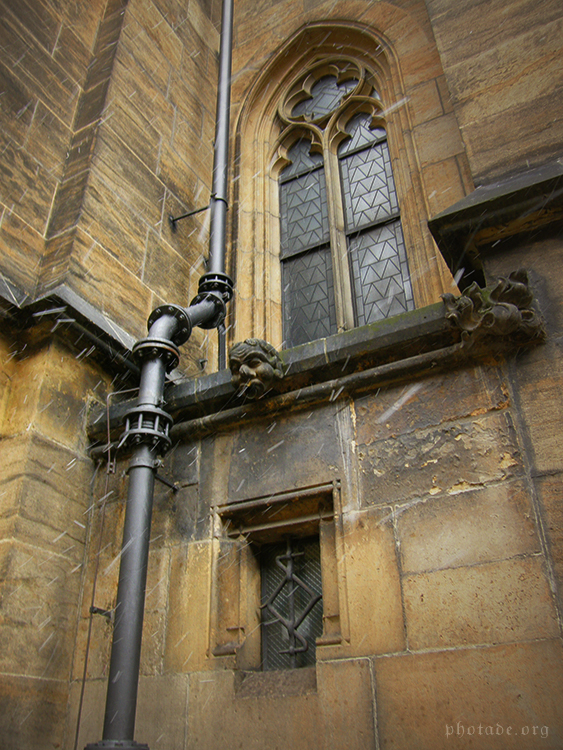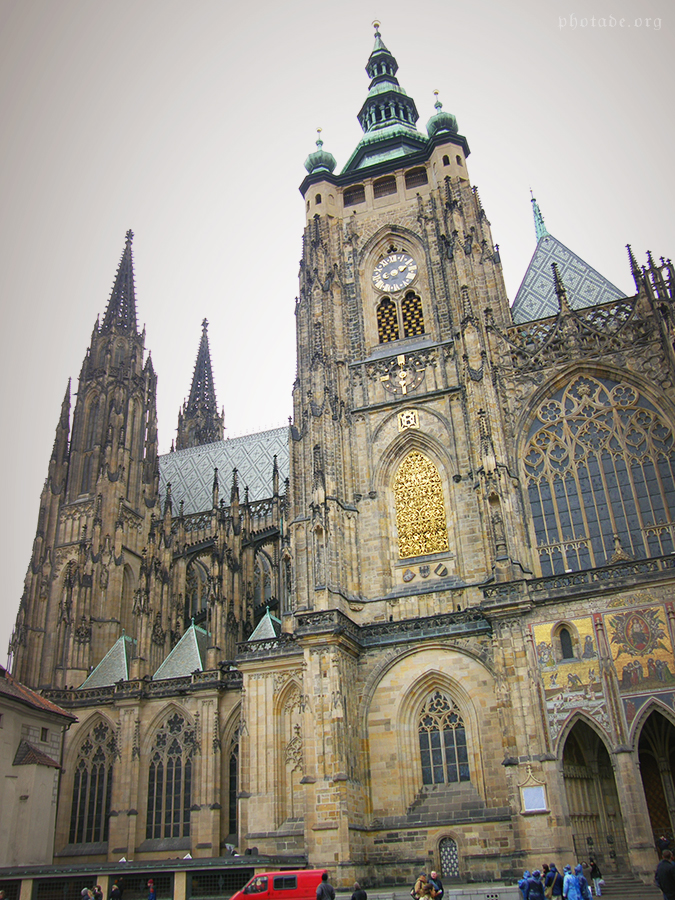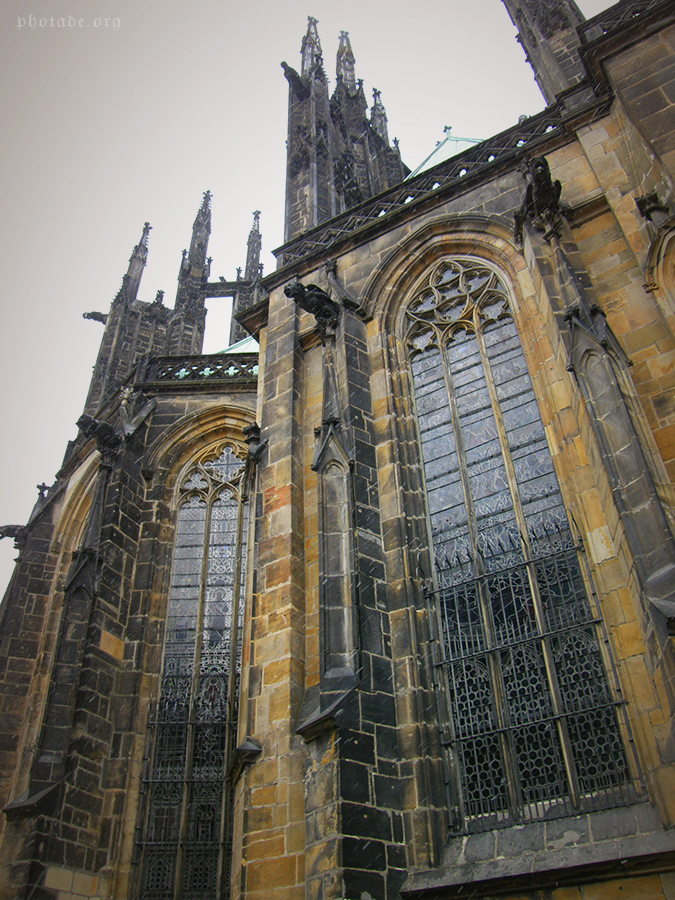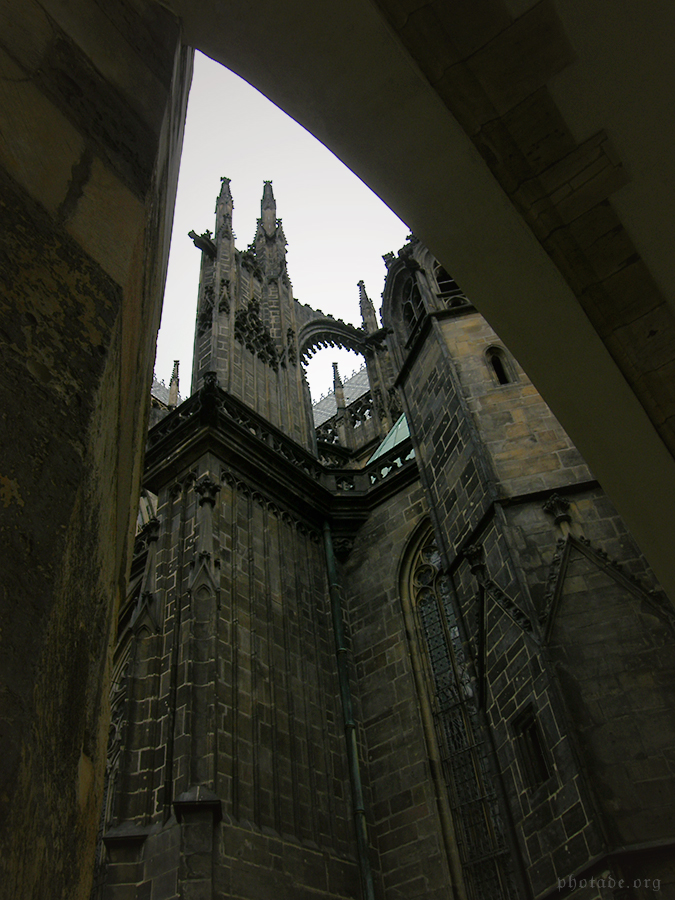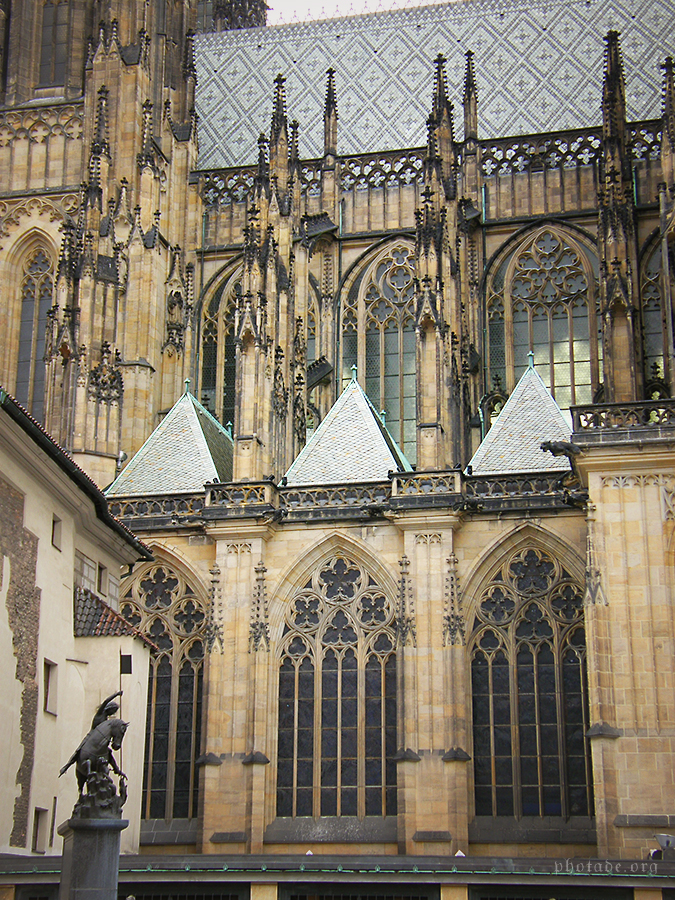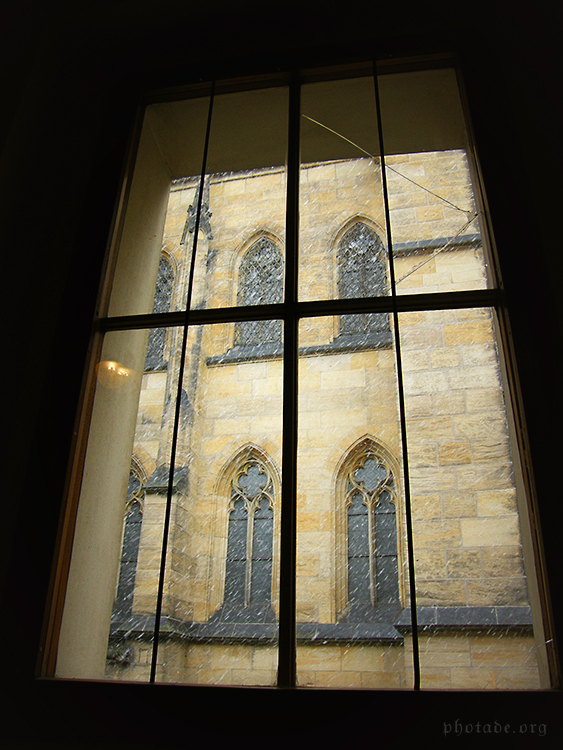 |
||
|
Собор Святого Вита (полное наименование ― собор Святых Вита, Вацлава и Войцеха) ― одна из центральных жемчужен готической архитектуры не только Чехии, но и всей Европы. Это уникальное сооружение строилось почти 6 веков, оно является одним из самых старых долгостроев Европы (наряду с Кёльнским собором, чьи образы в нём, кстати, совершенно правильно угадываются) и, несомненно, одним из самых красивых образцов готического архитектурного направления. Величественный, он возвышается над Пражским Градом монументальной рукотворной скалой, являясь главной архитектурной доминантой всей Праги в целом. Этот собор по праву можно назвать самой главной архитектурной достопримечательностью Чехии, и при этом ― это неотъемлемая часть мирового культурного наследия, ибо это грандиозное сооружение справедливо можно поставить в один ряд с такими мировыми архитектурными шедеврами, как, например, Эйфелева башня, Пирамиды в Гизе или собор Василия Блаженного. Первый камень на строительство этого храма был заложен 21 ноября 1344 года Карлом IV, архиепископом Арноштом из Пардубиц и Иоганом Люксембургским. Карл IV, судя по всему, к этому времени уже успел познакомиться с образцами готической архитектуры Франции, где он побывал к этому времени и успел убедиться, сколь этот новый архитектурный стиль красив и гармоничен. При этом у Карла IV была задумка превзойти французские образцы. Для строительства он вызвал французского архитектора Маттиаса (Матьё) Аррасского, который, впрочем, не успел достроить собор, так как в 1352 году он умер. Потом строительством занялся другой архитектор Петр Парлерж, после которого строительством занялись уже его сыновья Ян и Вацлав. Маттиас задумал собор по образцу французских соборов, но его последователи, выполнив все задумки первоначального строителя, впоследствии стали привносить свои идеи и новшества. Тут надо заметить, что строительству помешали гуситские войны (начавшиеся в 1419 году), из-за которых возведение храма не только приостановилось, но и кое-что успело пострадать от этих нашествий. В итоге к середине XV века собор был построен только наполовину. Затем собор строили другие архитекторы. Учитывая влияние времени, в какой-то момент во внешнем облике собора появились и барочные элементы, которые потом, к счастью, убрали, чтобы не доводить внешний облик собора до абсурда. Надо сказать, что собор ещё успел и погореть (пожар случился в 1541 году), после чего даже колокола заново отливали. На самом деле история строительства сложная, с постоянными достройками и разрушениями (источник 1, источник 2). При этом ещё и денег иногда не хватало, что также не способствовало ускорению строительства. Кроме того, для католиков не обязательно достраивать храм до конца, чтобы совершать там молебны, им достаточно возвести алтарь и хотя бы какие-то намётки на стены, чтобы было где собраться народу и совершить свои литургии. Поэтому храм несколько раз освящали, ибо после перестроек он так или иначе приобретал новый облик. Последняя глобальная перестройка храма началась в 1844 году, когда Ворцлав Песина и Йозеф Краннер предложили программу окончания строительства собора, последний, кстати, этим и занимался с 1861 по 1866 годы, возведя только одну неоготическую башню из ныне существующих двух. После его смерти достройкой собора занимался уже не менее талантливый архитектор Йосеф Моцкер, также не сумевший до своей естественной кончины окончить это грандиозное строительство. Третьим и уже последним архитектором нынешнего вида собора стал уже Камил Гилберт, который достроил-таки собор в 1929 году, по поводу чего получил звание почётного доктора Технического университета в Праге и был назначен действительным членом Чешской академии наук и искусств (видимо, любой, кто смог бы это дело довести до конца, получил бы это звание, потому что шестисотлетний долгострой кого хочешь доконает). И это мы не рассмотрели аспект, что на этом месте первый храм появился ещё в Х веке ― святой Вацлав построил небольшую ротонду (типичную для того времени), посвящённую святому Виту, десницу которого он получил в дар от короля Генриха I (некоего собирателя земель германских из Саксонии времён конца первого тысячелетия н.э.). Тысячу лет на этом месте молились, короновались, устраивали пышные торжественные похороны высшей чешской знати. Сейчас это больше место для привлечения туристов и иногда здесь организуют небольшие концерты органной музыки (орган собора ― один из лучших в Европе), правда, очень редко. Что касается религиозных событий, то это центральная церковь пражской архиепархии, и при этом у церкви есть свой приход. В соборе регулярно совершаются утренние (ежедневно) и вечерние (по пятницам и воскресеньям) службы. Туристов пускают, разумеется, за деньги в строго отведённые для этого часы, не пересекающиеся со службами. Очереди здесь, кстати, огромные, так что желающим посетить это место надо приходить заранее. Тем более что внутри есть что посмотреть ― прежде всего это великолепные надгробия (в том числе и из серебра) и витражи работы знаменитого Альфонса Мухи. Фасад собора сохранил влияние того времени, в которое он был задуман. Не смотря на долгую историю создания, в нём всё ещё чувствуется дух мрачного Средневековья: это и гаргульи на стенах, и соответствующий стиль изображений, свойственный тому периоду (неловкое изображение человеческих фигур близко по своей технике к детским рисункам). Южный фасад здания украшен огромной золотой мозаикой (82 м2) с изображением сцен из Страшного Суда (что также относит нас к готике, ибо это не самые радостные сюжеты из Святого Писания) и шести покровителей Чехии, просящих у Христа божьей милости. Также южный фасад украшен часами с двумя циферблатами. Верхний показывает часы, нижний ― минуты. Есть у этого собора и свои куранты. Размер собора 124 х 60 метров, высота самой высокой (южной) башни ― 96,5 м, высота двух западных неоготических башен ― 82 м ([jnz . Диаметр круглого окна-розетки ― 10 м (кто бы мог подумать на самом деле, ибо масштабы храма можно осознать только в сравнении, картинки тут явно не помощник). На шпиль самой высокой башни водружён 3-х метровый флюгер в виде чешского льва с крестом в лапах, установленный на подшипнике. Надо заметить, что в XIX веке реставраторы собора планировали построить башни высотой 156 метров, но и без того они смотрятся выше чего бы то ни было в округе (сложно представить, зачем планировалось построить башни столь высокими). В любом случае это один из самых высоких соборов Европы. Вот такой небольшой экскурс в историю. Тут надо заметить, что у действительно значимых исторических объектов в современном интернете исключительно туристические описания, что не идёт памятникам истории и архитектуры на пользу. Не смотря на обилие ссылок, информации о соборе в Сети очень мало и большей частью все эти ссылки копируют друг друга. Впрочем, для нас важно, что, не смотря на долгое строительство, в эпоху, когда уже даже модерн фактически закончил своё существование, этот храм донёс до нас дух времени его исконных создателей, таким образом сохранив для нас память о том времени, о котором в общем-то и остались только легенды и предания. Как я уже говорила, архитектура ― самый честный исторический язык. И пусть люди, задумавшие это грандиозное строение, уже давно почили в Бозе, память о них будет жива до тех пор, пока мы сможем лицезреть грандиозные памятники, оставленные ими и их потомками. Будем надеяться, что память об этих временах и людях сумеет пройти сквозь века и этот собор простоит гораздо дольше, чем его строили, ибо это действительно один из самых красивых и грандиозных памятников европейской (да и мировой) архитектуры.
* * *
St. Vitus Cathedral (full name is The Metropolitan Cathedral of Saints Vitus, Wenceslaus and Adalbert) is one of the central gems of Gothic architecture not only in the Czech Republic, but also throughout Europe. This unique structure was built for almost 6 centuries. It is one of the oldest long-term constructions in Europe (along with the Cologne Cathedral, whose images in it are guessed) and, undoubtedly, one of the most beautiful examples of the Gothic architecture. This is majestic building, it rises above the Prague Castle as a monumental man-made rock, being the main architectural dominant of the whole of Prague. This cathedral can rightly be called the most important architectural landmark of the Czech Republic. At the same time, it is an integral part of the world's cultural heritage, because this grandiose structure can rightly be put on a par with such world architectural masterpieces as, for example, the Eiffel Tower, the Pyramids of Giza or Saint Basil's Cathedral. The foundation stone for the building of this temple was laid on 21 November 1344 by Charles IV, Archbishop Arnošt of Pardubice and John of Bohemia. Charles IV, apparently, by this time had already become familiar with the examples of Gothic architecture in France, where he had visited already and had time to see how beautiful and harmonious this new architectural style is. At the same time, Charles IV had an idea to surpass the French models. He called the French architect Matthias of Arras for the construction, who, however, did not have time to finish the cathedral, since he died in 1352. Then the construction was taken up by another architect Peter Parler, after which his sons Johann and Wenzel continued the building. Matthias conceived the temple on the model of the French cathedrals, but his followers, having fulfilled all the ideas of the original builder, later began to bring their own ideas and innovations. Here it should be noted that the construction was prevented by the Hussite wars (which began in 1419), because of which the construction of the temple was not only suspended, but also something managed to suffer from these invasions. As a result, the cathedral was only half built by the middle of the XV century. Then the cathedral was built by other architects. Consider the influence of time, in the external appearance of the cathedral there were also Baroque elements at some point, which then, fortunately, were removed due to not to bring the appearance of the cathedral to the point of absurdity. I have to say that the cathedral managed to burn down (the fire happened in 1541), after which even the bells were cast again. In fact, the history of building is complex, with constant additions and destruction (source 1, source 2). Sometimes there was not enough money, which also did not contribute to the acceleration of construction. Also, for Catholics, it is not necessary to finish building the church to perform prayers there. They just need to erect an altar and at least some walls, that there is a place for people to gather and celebrate their liturgies. Therefore, the temple was consecrated several times, because it had received a new appearance after the rebuilding. The last global reconstruction of the temple began in 1844, when Václav Pešina and Josef Kranner proposed a program for the completion of the construction of the cathedral. Josef Kranner did it from 1861 to 1866, erecting only one neo-Gothic tower out of the two that now exist. After his death, talented architect Josef Mocker tried to finish the building of this cathedral, but he didn't succeed either. The third and last architect of this cathedral was Kamil Hilbert, who completed the cathedral in 1929, for which he received the title of honorary doctor of the Technical University in Prague and was appointed a full member of the Czech Academy of Sciences and Arts (apparently, anyone who could finish this work, would get this title, because a six-hundred-year long construction is too long). And we did not consider the aspect that the first temple appeared on this place in the X century. Saint Wenceslaus built a small rotunda (typical of the time) dedicated to Saint Vitus, whose right hand he received as a gift from King Henry I (a certain collector of German lands from Saxony at the end of the first millennium AD). For a thousand years, this place was used for prayers, crowns, and lavish funerals of the highest Czech nobility. Now it is more a place to attract tourists and sometimes small organ concerts are organized here (the cathedral organ is one of the best in Europe), although very rarely. As for religious events, this is the central temple of the Archdiocese of Prague, and the church has its own parish. The cathedral regularly celebrates morning (daily) and evening (Friday and Sunday) services. Tourists can visit the cathedral, of course, for money in strictly designated hours, not intersecting with the services. The queues here, by the way, are huge, so, those who want to visit this temple should come in advance. There is something to see inside ― first, these are magnificent tombstones (including silver) and stained-glass windows by the famous Alphonse Mucha. The facade of the cathedral retains the influence of the time in which it was conceived. Despite the long history of its creation, it feels the spirit of the dark Middle Ages: these are gargoyles on the walls, and the corresponding style of images peculiar to that period (the awkward depiction of human figures is close in its technique to children's drawings). The southern facade of the temple is decorated with a huge golden mosaic (82 m2) depicting scenes from the Last Judgment (which also refers to the Gothic, because these are not the most joyful scenes from Holy Scripture), and the six patrons of Czechia, asking Christ for God's mercy. Also, the southern facade is decorated with a clock with two dials. The upper one shows the hours, the bottom one shows the minutes. This cathedral also has chimes. The size of the cathedral is 124 x 60 meters, the height of the highest (southern) tower is 96.5 m, the height of the two western neo-Gothic towers is 82 m. The diameter of the round window-rosette is 10 m (it's hard to believe, because the scale of the temple can only be realized in comparison, pictures are not an assistant here). A 3-meter weather vane in the form of a Czech lion with a cross in its paws, mounted on a bearing, is mounted on the spire of the highest tower. We should to note that in the XIX century, the restorers of the cathedral planned to build towers with a height of 156 meters, but even without that, they look higher than anything in the city (it is difficult to imagine why it was planned to build towers so high). In any case, it is one of the highest cathedrals in Europe. Well, it was a small excursion into history. Here it should be noted that the really important historical objects on the modern Internet have only tourist descriptions, which does not benefit historical and architectural monuments. Despite the abundance of links, there is very little information about the cathedral on the Web, and all these links copy each other for the most part. However, it is important for us that, despite the long construction, in an era when even Art Nouveau actually ended its existence, this temple brought to us the spirit of the time of its original creators, thus preserving for us the memory of that time, about which only legends and legends remain. As I said before, architecture is the most honest historical language. And even though the people who conceived this grandiose structure have long since fall asleep in the Lord, their memory will be alive as long as we can contemplate the grandiose monuments left by them and their descendants. Let's hope that the memory of these times and people will be able to pass through the centuries, and this cathedral will stand much longer than it was built, because it is really one of the most beautiful and grandiose monuments of European (and world) architecture.
2017, translated in 2021
|
||
 1 |
||
 2 |
||
|
||
 4 |
||
|
||
 6 |
||
|
||
 8 |
||
|
||
 10 |
||
|
||
 12 |
||
|
||
 14 |
||
|
||
 16 |
||
|
||
 18 |
||
|
||
|
||
 21 |
||
|
||
|
||
|
||
|
||
 26 |



